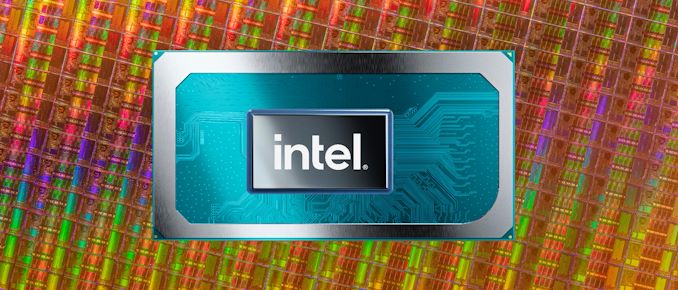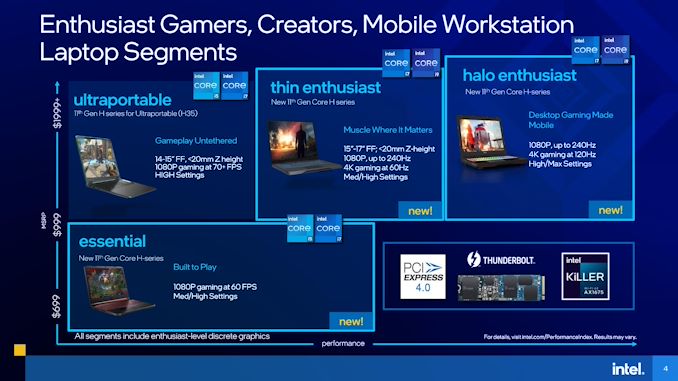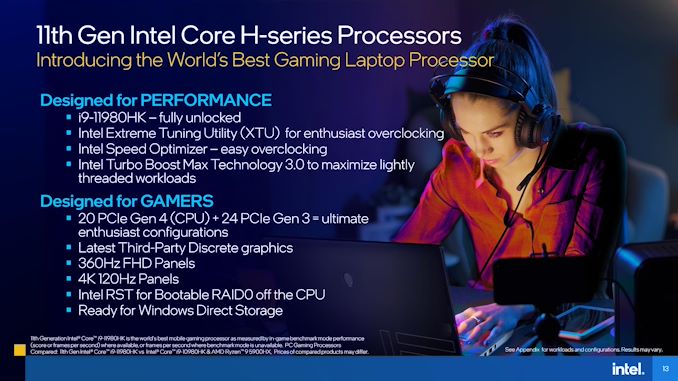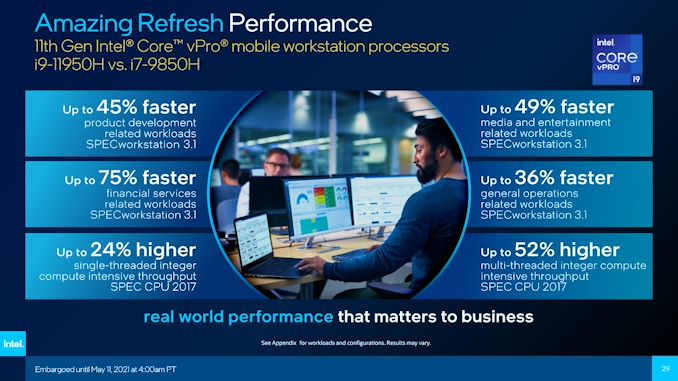Intel Launches 11th Generation Core Tiger Lake-H: Eight Core 10nm Mobile Processors
by Dr. Ian Cutress on May 11, 2021 7:00 AM EST- Posted in
- CPUs
- Intel
- Overclocking
- 10nm
- Xe-LP
- Willow Cove
- Tiger Lake-H
- i9-11980HK
- TGL-H

Ever since the launch of the first series of Intel Core 11th Generation Tiger Lake processors aimed at the ‘U-series’ 15 W market, Intel has teased us that there was another design being produced in the wings. While the Tiger Lake-U was built for portability, battery life, and integrated graphics, the Tiger Lake-H series would double the cores, and be the partner for premium mobile gaming as well as on-the-go muscle. Today is the launch of this new platform, and Intel is promoting over 1 million Tiger Lake-H processors shipped to partners and 80 devices coming to market.
A Quick Recap: Intel Mobile Segmentation
For those who are unfamiliar with Intel’s mobile strategy, it falls into several categories, usually designated by the letter. Over time Intel has been moving around within these categories to define different design points for end-user products, but they have by and large stayed the same. As follows:
| AnandTech | Main TDP |
TDP Range |
Info |
| Y-Series | - | 4-10 W | Novel small form factor Sustained battery life |
| U-Series | 15 W | 12-28 W | 10-14 inch ultraportable Usually reliant on integrated graphics. Some with discrete GPU for portable gaming |
| H35-Series | 35 W | - | New for Tiger Lake. Not actually H, just a high-powered U. |
| H-Series | 45 W | 35-65+ W | 14-17 inch high-performance More cores, discrete graphics 'portable' high-performance gaming Workstation/desktop replacements |
For the new eight-core Tiger Lake-H processors, Intel highlights three key markets:
- Essential: Paired with mid-range GPU, 1080p Gaming at 60 FPS, Medium/High Settings
- Thin Enthusiast: 15+ inch, sub-20 mm, Gaming at 1080p240 or 4K60 at Medium/High
- Halo Enthusiast: 15+ inch, Gaming at 1080p240 or 4K120 at High/Max Settings
The new H-series processors will also have corresponding vPro versions for commercial deployment, and Intel is saying that out of the 80+ designs currently using the new 11th Gen Core Tiger Lake-H, about 15 of them will be vPro focused.
Tiger Lake-H (TGL-H) Processors on Offer
While users might be accustomed to seeing a wide array of Intel processors each differing by the smallest of margins, today’s launch has only five models for consumers, and another five for commercial systems. At the heart are Intel's latest Willow Cove processor cores, with 1.25 MB of exclusive L2 cache, and up to 3 MB of shared L3 cache per core, along with Intel's latest Xe-LP graphics. These all start at six cores and twelve threads, and offer up to 5.0 GHz single-core turbo for the most expensive models.
| Intel Tiger Lake-H Consumer | |||||||||
| AnandTech | Cores Threads |
35W Base |
45W Base |
2C Turbo |
4C Turbo |
nT Turbo |
L3 Cache |
Xe GPU |
Xe MHz |
| i9-11980HK | 8C/16T | - | 2.6 | 5.0* | 4.9 | 4.5 | 24 MB | 32 | 1450 |
| i9-11900H | 8C/16T | 2.1 | 2.5 | 4.9* | 4.8 | 4.4 | 24 MB | 32 | 1450 |
| i7-11800H | 8C/16T | 1.9 | 2.3 | 4.6 | 4.5 | 4.2 | 24 MB | 32 | 1450 |
| i5-11400H | 6C/12T | 2.2 | 2.7 | 4.5 | 4.3 | 4.1 | 12 MB | 32 | 1450 |
| i5-11260H | 6C/12T | 2.1 | 2.6 | 4.4 | 4.2 | 4.0 | 12 MB | 32 | 1400 |
| *Turbo Boost Max 3.0 | |||||||||
The most premium model is the Core i9-11980HK, which looks more akin to a desktop processor! Intel has the eight-core part rated at 2.6 GHz for 45 W, but also lists a base frequency of 3.3 GHz for 65 W. What makes this processor special compared to the others is that it can also be overclocked further than 65 W in systems that allow it. Overclocking on laptops is usually a bit hit and miss, but this is actually the first ever overclockable 10nm processor from Intel. That accolade typically goes to the desktop platform, but this is the first time in recent memory I’ve seen Intel launch an overclockable mobile processor first.
The Core i9-11980HK gets the best of Intel’s design here: 4.5 GHz all-core turbo, 4.9 GHz traditional turbo, and 5.0 GHz with Turbo Boost Max 3.0 on up to two favored cores. The integrated graphics is the base Xe-LP architecture with 32 execution units running at 1450 MHz peak. All processors listed have 32 execution units, with a 350 MHz base and variable peak frequencies.
The other processors here follow Intel’s traditional non-overclocked schema, whereby 45 W is the standard rating and 35 W is the power-down option. The Core i9-11900H for example has Turbo Boost Max 3.0 on two cores up to 4.9 GHz, like the other Core i9, and TBM 3.0 is the main difference down to Core i7 which is also eight-core and sixteen thread.
Compared to Intel’s best TGL-U processors, the Core i7-11375H SE (35W) and the Core i7-1185G7 (28W) are quad-core processors but have much better-integrated graphics.
| Intel Tiger Lake-H Commercial | |||||||||
| AnandTech | Cores Threads |
35W Base |
45W Base |
2C Turbo |
4C Turbo |
nT Turbo |
L3 Cache |
Xe GPU |
Xe MHz |
| W-11955M | 8C/16T | 2.1 | 2.6 | 5.0* | 4.9 | 4.5 | 24 MB | 32 | 1450 |
| i9-11950H | 8C/16T | 2.1 | 2.6 | 5.0* | 4.9 | 4.5 | 24 MB | 32 | 1450 |
| i7-11850H | 8C/16T | 2.1 | 2.5 | 4.8 | 4.8 | 4.3 | 24 MB | 32 | 1450 |
| W-11855M | 6C/12T | 2.6 | 3.2 | 4.8* | 4.7 | 4.4 | 18 MB | 32 | 1450 |
| i5-11500H | 6C/12T | 2.4 | 2.9 | 4.6 | 4.4 | 4.2 | 12 MB | 32 | 1450 |
| *Turbo Boost Max 3.0 | |||||||||
On the commercial front, Intel is mixing up the names between Core and new Xeon W-11000M series processors. There is no overclockable processor here, but the specifications are somewhat identical with 45 W as standard and 35 W optional operating modes. These processors differ because they feature Intel’s vPro, a commercial system allowing for company administration control, Intel Hardware Shield, Total Memory Encryption, and a number of other features to assist deployment across the infrastructure of a business-focused environment. These processors also have ECC memory support, and will defend against cryptocoin mining through detection when used with Microsoft Defender Endpoint.
It is worth noting here that the W-11855M is the odd processor out. It has six cores, but comes with Turbo Boost Max 3.0. It also has 18 MB of L3 cache, the full 3 MB per core, whereas the other 6C processors only have 2 MB per core. I suspect that the W branding is often associated with having as much cores and cache as possible, as in previous generations this has usually been the case.
Tiger Lake-H Silicon and Platform
Compared to the previous Tiger Lake-U silicon, we now get a full eight Willow Cove cores on die, up from four, as well as 20 lanes of PCIe 4.0 for discrete graphics and storage. The overall silicon measures in at around 190 square millimeters, uses Intel’s latest Xe-LP graphics and media engines enabling AV1 decode support, and also has built-in Thunderbolt 4 controllers.
All Tiger Lake-H processors will support DDR4-3200, however it is worth noting that these processors do not support LPDDR4. We expect this to be a more holistic choice that these platforms are not battery life focused, and TGL-H customers prefer having DDR4 as it supports double the capacity (as well as usually being user-replaceable, depending on the design).
The 20 lanes of PCIe 4.0 can be split in three different ways:
- x16 for graphics, x4 for storage
- x8/x8 for graphics, x4 for storage
- x8 for graphics, x4/x4/x4 for storage
In the latter configuration, with up to three PCIe 4.0 x4 storage devices, Intel also supports bootable RAID 0. This is somewhat an obscure configuration, however we have seen MSI desktop-replacement systems come with multi-drive RAID 0 in the past.
The chipset for TGL-H is separate to the CPU, and so there will be a number of mobile chipsets on offer, however Intel has updated the most powerful chipset to a DMI x8 link, offering double the bandwidth back from the chipset to the processor. From the chipset there are another 24 PCIe 3.0 lanes as well as MIPI support for Intel’s Image Processing Unit 6.
Thunderbolt 4 is natively supported, although USB4 is not listed. There is USB 3 support, however Intel fails to list if this is USB 3.2 Gen 1 or Gen 2. For networking, systems can either use a discrete Ethernet controller, or use the chipset integrated Killer AX1675 Wi-Fi 6E solution (if the OEM purchases the corresponding Intel CNVi RF interface). For those of you wondering why Intel is pairing with Killer for the networking here, it’s because Intel acquired the company behind Killer, Rivet Networks, last year for an undisclosed sum.
Intel promotes that TGL-H is ready for Windows Direct Storage, and with appropriate third-party discrete graphics can support the latest 360 Hz 1080p panels or the latest 4K 120 Hz panels. Resizeable BAR is also supported.
Performance
As always with these launches, Intel provides first-party benchmark numbers. We’re loathed to mention any of them, simply because we prefer to validate the claims ourselves.
One thing we can already confirm however is the raw processor improvements: as we saw in previous Tiger Lake systems, Intel offers ‘up to 19%’ better performance per clock over the previous generation. In this comparison, Intel is comparing Tiger Lake-H to Comet Lake-H, which is a derivative of Intel’s 6th Generation architecture. Gains in that market are very much an average of 19%.
But it might be worth noting that comparing against Comet Lake-H is not comparing against Intel’s architectures in chronological order. If we compare Tiger Lake to Intel’s previous 10nm product, Ice Lake, the design of the core means that while some benchmarks did improve, others regressed, leading to overall parity in performance compared to Ice Lake. The only reason Intel isn’t comparing against Ice Lake in its product comparisons is because Ice Lake at 15 W against Tiger Lake at 45 W is too big a power disparity, and mainly a frequency differential will drive Tiger Lake higher.
Intel’s benchmarks against AMD are a bit trickier, given it is hard to compare laptop-vs-laptop given that different designs will have different optimization points. However in an iso-comparison with an RTX 3080 (giving AMD the benefit of the doubt on TDP and a bigger chassis for cooling), and with all settings and cooling features and fans set to maximum, Intel is claiming 20% better average gaming performance with a Core i9-11980HK (65W?) against a Ryzen 9 5900HX (45W?), or iso-performance comparing a Core i5-11400H (45 W?) and a Ryzen 9 5900HS (35 W?). There are a lot of question marks there because Intel’s appendix of test setups mentions only ‘maximum performance setting’ for each system, and that in-itself is variable based on the OEM.
The one performance slide that’s good to put up is probably this one, where Intel compares an example 3-year refresh performance improvement for a commercial high-end system. Some of these workloads can leverage the AVX-512 units, the Xe-LP graphics, or other accelerators that Intel now includes in Tiger Lake-H.
Timescale and Availability
Intel’s launch today states that there are 80+ enthusiast designs with Tiger Lake-H, however exactly how many will be available today is an unknown – we suspect that these designs will come out over the rest of the year. Intel also lists 1 million TGL-H processors shipped to its OEM partners by launch. Normally Intel discloses a few key partner designs with us alongside the launch, but this time that did not happen. NVIDIA also has a corresponding launch today for products designed to fit well with these sorts of systems, so perhaps there is some sort of tie-in. The systems are being launched worldwide, but the launch event is officially in China, hence the early morning US announcement today.
We’re expecting to get hold of a couple of Tiger Lake-H systems for testing over the next month or so – a ‘high-end’ example as well as a halo design.














164 Comments
View All Comments
Spunjji - Monday, May 17, 2021 - link
@mode13h - that's what I'm taking from it, too. A density reduction could improve overall production output if it increased yields, and the claims of improved performance seem plausible.Spunjji - Monday, May 17, 2021 - link
I've not seen any reliable information about the density changes between Intel's processes. My reading-between-the-lines of their publicity on SF was that it constituted a further relaxation in density over Ice Lake's 10nm(+) - otherwise they'd have boasted about density alongside all the positive characteristics they mentioned - but I could conceive of ESF modifying the transistors in a way that doesn't affect overall density much over SF.zodiacfml - Wednesday, May 12, 2021 - link
finally but a bit pointless except the highest end products, considering quad core tiger lakes already costs as much eight core Ryzen parts.xpclient - Thursday, May 13, 2021 - link
Without seeing any benchmarks yet, I'd I/O is the main upgrade here and the CPU performance gap with AMD is slightly reduced but AMD still maintains a lead easily.Some Tiger Lake H45 laptops are having 2 x M.2 PCIe Gen 4 SSDs, all USB 3 Gen 1 (5 Gbps) ports upgraded to USB 3 Gen 2 (10 Gbps) and 2 x Thunderbolt 4! Now that's massive.
But these are overpriced by Intel despite AMD CPUs/APUs offering better performance for the buck. I see many Intel Tiger Lake *Quad core* laptops costing more than 8 core AMD Ryzen 5000 laptops. And Thunderbolt 3/4 peripherals and adapters still set you back by another $150-$250
lmcd - Saturday, May 15, 2021 - link
Doesn't change that Thunderbolt docks are still far and away superior to USB 3 with alt mode docks. It's not even close. If I were to provision laptops for a company, there's no question I would standardize on Thunderbolt.Also, better cooling solutions for the high end parts, which usually comes with the H-series unless you buy MSI, should help close the gap.
mode_13h - Sunday, May 16, 2021 - link
Doesn't this have USB 4? In which case, the distinction should become moot.lmcd - Sunday, May 16, 2021 - link
The point is that the "adapters and peripherals setting you back" isn't a like for like comparison. The experience with Thunderbolt docking isn't just numerically better, the plug-and-play experience is more reliable with Thunderbolt as well, to such an extent that the price comparison xpclient brought up isn't relevant.Spunjji - Monday, May 17, 2021 - link
I *have* had plug-and-play issues with Thunderbolt docking before, but it was with Dell kit, and the problems were resolved by firmware updates. Overall I'd agree the experience is superior enough to justify the extra cost, because you don't have to go looking to find out whether, for example, your USB-C 3 port supports HBR2 or HBR3 just to know what sort of monitors you can plug into it...I'm a little disappointed that Thunderbolt accessories haven't really dropped in price much over the years, though.
sandeep_r_89 - Monday, May 17, 2021 - link
Any word on Tigerlake-H NUCs ?mode_13h - Tuesday, May 18, 2021 - link
If Intel sells them, my guess is that they'll be like the NUC9 extreme, which aren't really NUCs in any proper sense.